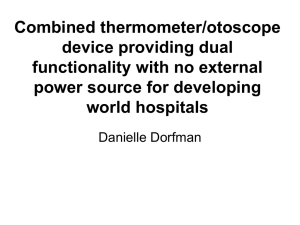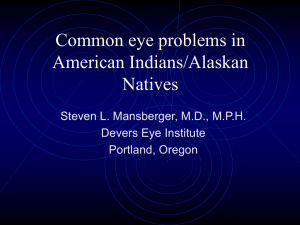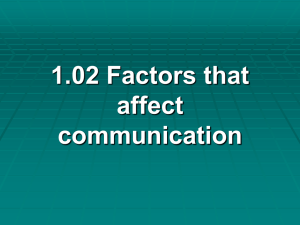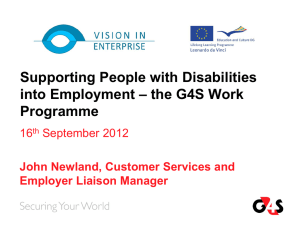Module 4: Impairment
advertisement
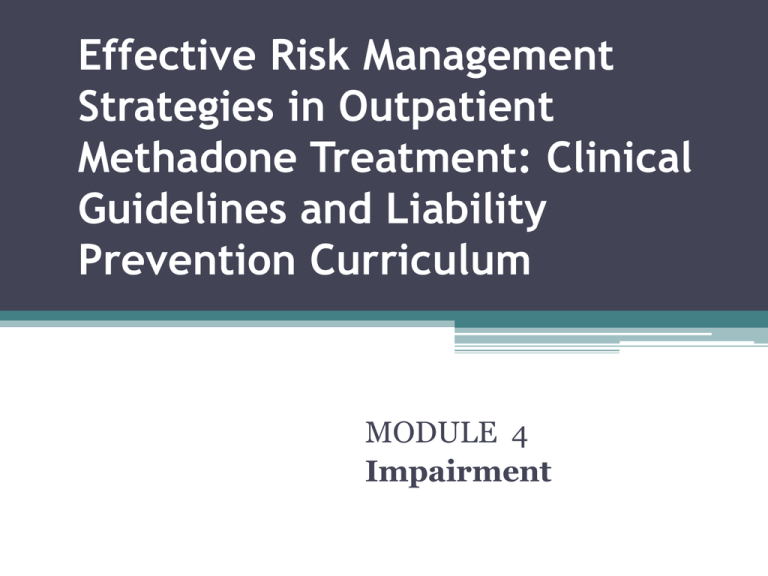
Effective Risk Management Strategies in Outpatient Methadone Treatment: Clinical Guidelines and Liability Prevention Curriculum MODULE 4 Impairment Impairment • Impairment: ▫ Definition and general understanding ▫ Legal perspective ▫ Medical/Clinical perspective • Assessment for impairment • High risk situations in OTPs • Risk Management strategies • • • • Impairment Intoxication Competence Informed consent • Disability Legal Definition of Impairment • A person's faculties are reduced so that his/her ability to see, hear, walk, talk and judge distances is below the normal level. • Generally caused by drug or alcohol use. Medical Definition of Impairment Any abnormality of (partial or complete loss of), or loss of the function of a body part, organ, or system. Intoxication Medical Definition Legal Definition • A pathologic state induced by an exogenous or, less commonly, endogenous toxic substance. • A state in which a person's normal capacity to act or reason is inhibited by alcohol or drugs. • An intoxicated person is incapable of acting as an ordinary, prudent and cautious person would act under similar conditions. Alcohol Sedative-hypnotic Anxiolytic Opioids Stimulants Hallucinogens DSM-IV Criteria for Intoxication Alcohol A. Recent use of alcohol. B. Clinically significant maladaptive behavioral or psychological changes that developed during, or shortly after alcohol use. C. One or more of the following: 1. 2. 3. 4. 5. 6. Slurred speech Incoordination Unsteady gait Nystagmus (eye movement) Impairment in attention or memory Stupor or coma D. The symptoms are not due to a general medical condition and are not better accounted for by another mental disorder. DSM-IV Criteria for IntoxicationSedative,Hypnotic, Anxiolytic A. Recent use of a sedative, hypnotic or anxiolytic. B. Clinically significant maladaptive behavioral or psychological changes that developed during, or shortly after sedative- hypnotic or anxiolytic use. C. One or more of the following: 1. 2. 3. 4. 5. 6. Slurred speech Incoordination Unsteady gait Nystagmus (discussed later) Impairment in attention or memory Stupor or coma D. The symptoms are not due to a general medical condition and are not better accounted for by another mental disorder. DSM-IV Criteria for Intoxication Opioid A. Recent use of and opioid. B. Clinically significant maladaptive behavioral or psychological changes that developed during, or shortly after opioid use. C. Pupillary constriction or pupillary dilation due to anoxia from severe overdose and one (or more) of the following signs, developing during, or shortly after opioid use: 1. 2. 3. Drowsiness or coma Slurred speech Impairment in attention or memory D. The symptoms are not due to a general medical condition and are not better accounted for by another mental disorder. Opioid Intoxication • Suspected when the clinical triad of CNS is present: ▫ Depression (lethargy, sedation, coma) ▫ Respiratory depression (vital signs important) ▫ Pupillary miosis (constriction) • Drowsiness • Conjunctival injection (redness of the eye) • Euphoria DSM-IV Criteria for Intoxication Stimulant A. Recent use of a stimulant. B. Clinically significant maladaptive behavioral or psychological changes (e.g., euphoria or affective blunting; changes in sociability; hypervigilance; interpersonal sensitivity; anxiety, tension or anger; stereotyped behaviors; impaired judgment; or impaired social or occupational functioning; that developed shortly after stimulant use. C. Two or more of the following, developing during, or shortly after stimulant use: 1. 2. 3. 4. 5. Tachycardia or bradycardia Pupillary dilation Elevated or lowered blood pressure Perspiration or chills Nausea or vomiting 6. Evidence of weight loss 7. Psychomotor retardation or agitation 8. muscular weakness, respiratory depression, chest pain, or cardiac arrhythmias 9. Confusion, seizures, dyskinesias, dystonias or coma D. The symptoms are not due to a general medical condition and are not better accounted for by another mental disorder. Acute Stimulant Intoxication Adrenergic: • • • • • • • • Dilated pupils Diaphoresis (profuse sweating) Hypertension (elevated blood pressure) Tachycardia (increased heartbeat), with or without arrhythmia and chest pain Hyperthermia (elevated temperature) Bruxism (teeth grinding) Tremors Seizures DSM-IV Criteria for Intoxication Hallucinogens A. Recent use of hallucinogen. B. Clinically significant maladaptive behavioral or psychological changes (e.g., marked anxiety or depression, ideas of reference, fear of losing one’s mind, paranoid ideation, impaired judgment or impaired social or occupational functioning) that developed during or shortly after hallucinogen use. C. Two or more of the following: 1. 2. 3. 4. 5. 6. 7. Pupilary dilation Tachycardia Sweating Palpitations Blurring of vision Tremors Incoordination D. The symptoms are not due to a general medical condition and are not better accounted for by another mental disorder. Competence – Forensic Perspective • Legal recognition of an individual's ability to perform a task. • Directed at a specific category of demands, such as: ▫ competence to assist counsel in preparing a defense ▫ competence to manage financial affairs ▫ competence to give informed consent in legal or medical matters Informed Consent – Forensic Perspective • Authorization given by a person: ▫ free from coercion or undue influence ▫ has been given adequate information on the decision to be made ▫ has the capacity to understand the information disclosed. • An incompetent patient is unable to authorize informed consent. Disability Forensic Perspective Medical Perspective •A physical or mental impairment that substantially limits one or more of the major life activities • “Disability” is commonly used when an entity providing benefits ( e.g. insurer, Social Security) to those unable to work requires the treating professional to certify that the patient is disabled •A record of such an impairment; or •Being regarded as having such an impairment Common Triggers for Assessment • History of recent prior episodes • Induction period • • • • Smell of alcohol, +BAC, +UDS Reports from other patients Staff observation Aberrant behavior Other Etiologies for Impairment • Medical condition or illness • Drug-drug interactions involving medications • Illicit substances use Impairment Assessment • Observation • Respectful conversation, reason for evaluation • Privacy and confidentiality • Simple diagnostic testing: BAC, UDS • Specific testing, MSE, MoCA, neurological exam • Handwriting, signature • Treatment plan review What Areas Need to be Assessed? Indicators of Intoxication / Impairment • Central Nervous System functioning • Autonomic Nervous System functioning Mental Status Examination • Appearance • Thought process • Attitude toward the examiner • Thought content • Mood • Affect • Speech • Insight • Judgment • Impulsivity • Reliability Assess: Appearance and Attitude • Physical and mental • Overt and obvious • Subtle Assess: Mood and Affect • Euthymic-Dysthymic-Manic • Angry-Irritable-Hostile • Calm-Anxious-Panic • Elated Assess: Speech • Spontaneous • Slow-Deliberate • Slurring • Rapid • Illogical Assess: Eyes • Nystagmus Nystagmus Appearance Horizontal Gaze (HGN) Sedative, hypnotic, Uneven movement of the eye anxiolytics (alcohol, in the horizontal direction in barbiturates, both directions benzodiazepines) Vertical Gaze (VGN) phencyclidine (PCP), Uneven movement of the eye ketamine or even in the vertical direction high dose morphine. Uneven movement in only one direction and not the other May Indicate Inner ear issue • Pupils constricted-Dilated-Uneven-Reactive Assess: Psychomotor Status Sedated Alert • Unconscious • Hyper alert • Stuporous • Hyperactivity • Conscious but drowsy • Cooperative • Some psychomotor retardation • Combative Assess: Gait • Walk-and-turn • One-leg stand • Romberg • Finger to nose • Heel to toe walking in a straight line (Sobriety Test) Assess: Orientation • Time • Place • Person • Situation • Space Assess: Memory • Immediate • Remote • Recent Assess: Vital Signs • Temperature • Pulse • Respirations • Systolic BP • Diastolic BP Impairment and RM • Impaired patients present potential danger to themselves and others. • Impaired patients are prohibited from: ▫ Operating heavy equipment, machinery ▫ Driving motor vehicles, automobiles, motorcycles, motorbikes, boats • Suspicion of impairment should trigger a set of preemptive actions. Impairment: High Risk Situations • During the induction process • Drug-Drug interactions with methadone involving illicit drugs and or prescribed medications: ▫ ▫ ▫ ▫ ▫ ▫ Heroin, opioid pain relievers Benzodiazepines Alcohol Cocaine Other sedative-hypnotic medications Muscle relaxants Prescribed Medications • The impairment must be dealt with first • Then the treatment plan can be amended to deal with the longer term issues Risk Management Strategy for Impairment Educate all patients Inform of policy and procedures Total OTP community effort Climate of Impairment Awareness Identifying Impaired Patients Identifying Impairment: Reasonable Inquiries • Conduct regular inquiries directly with all patients • For new patients and alcohol/substance abuser verbal inquiries may not be enough What are your RM options for Impairment during induction? Impairment: Risk Treatment Options (Induction) 1. Accept or assume all/some of the risk. ▫ Accept risk that new patients will experience impairment. ▫ Limit risk during induction by making patients remain at the OTP for the full first day, then reducing time. ▫ Impose a call-in process. Impairment: Risk Treatment Options (Induction) 2. Avoid risk- by abandoning or eliminating source of risk. ▫ ▫ Insist inductions be done inpatient Only accept stable patients Impairment: Risk Treatment Options (Induction) 3. Mitigation (Control Loss) - reduce frequency, likelihood, severity and/or impact loss: ▫ Policy & Procedures ▫ Utilize patients as resources ▫ Delay dispensing medication ▫ Take reasonable action to assure the patient is transported safely Impairment: Risk Treatment Options (Induction) 3. Transfer Risk to a capable third party: ▫ Informed Consent ▫ Refer to other facility RM Decisions: Addressing Impairment • Medicate • Medicate and monitor • Do not medicate and further monitor • Do not medicate, arrange for transport home Cases Where OTPs Knew or Should Have Known… • “Red flag” patient would drive while impaired • Medicating knowing patient would drive impaired • Evidenced ignored • Benzodiazepine use (licit or illicit) OTPs’ Duties: Addressing Impairment Duty to: • Inform (consent process) • Warn • • Observe • Assess/monitor • Investigate polydrug issues • Delay, defer or refuse dispensing methadone • Assess and act if patient poses a foreseeable risk • Report potentially dangerous situations Summary: Legal Standard • OTPs must take all precautions and “reasonable action” to : ▫ Assure a patient is not impaired prior to dosing ▫ Inform the patient of the side effects ▫ Prevent the impaired patient from driving • OTPs have a legal duty to take action once impairment is identified Summary: Addressing Impairment • Adopt a “No Tolerance” clinic policy for impairment with communication to patients • Phased informed consents, release of information • Discuss concerns privately, maintain confidentiality • Diagnostic instruments / tools for assessment • Staff training • Document

